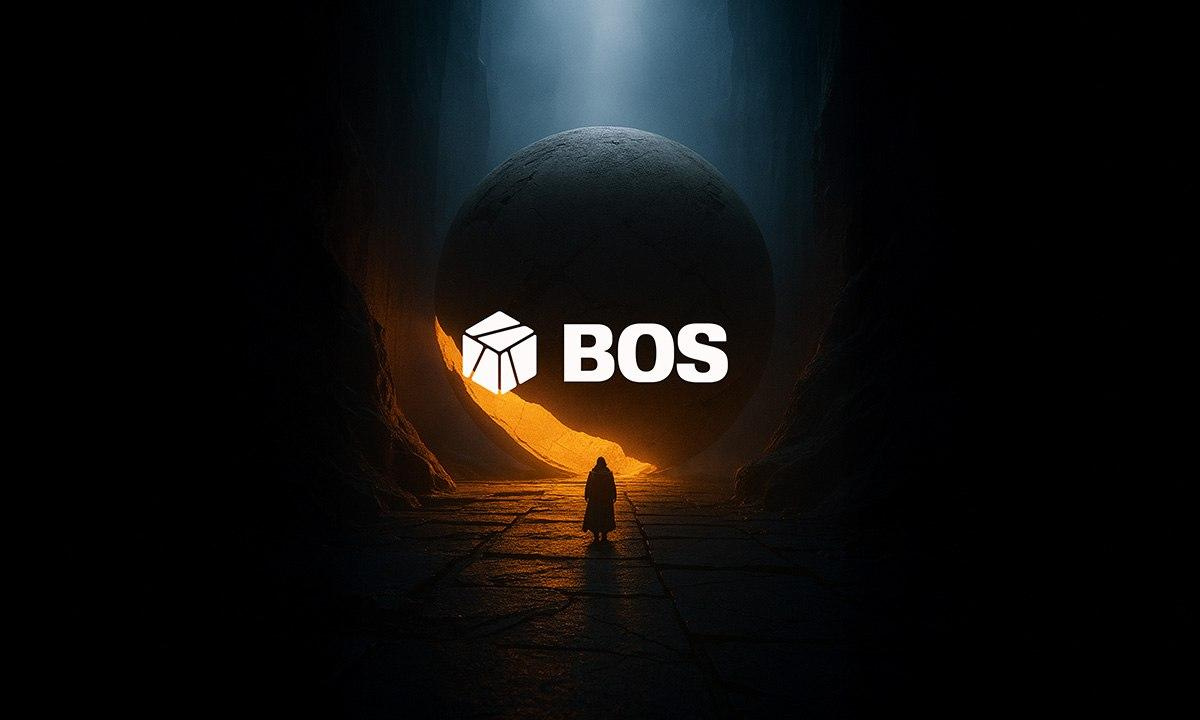BridgeLive Feed
Bridge breaking news and instant alerts. Crypto Feed's minimalist interface delivers verified headlines, price movements, and protocol updates the moment they happen. Fast, focused, no fluff.
 XRP Could Drive The ‘Biggest Economic Shift’ In Decades: Crypto Expert
XRP Could Drive The ‘Biggest Economic Shift’ In Decades: Crypto ExpertVincent Scott, a well-known voice in the XRP community, urged patience while restating a big claim: he called XRP and the XRP Ledger humanity’s “best chance” to change how money moves around the globe. His message, shared on X, mixed optimism about Ripple’s corporate moves with a warning that legal clarity must come first. License Moves And Market Positioning According to Scott, Ripple’s licensing work, recent acquisitions and new partnerships show the company is lining up for much bigger demand for XRP. He argued the token’s real value is practical — it can act as gas for transactions or as a bridge currency to move value between different systems. XRP/XRPL is the best chance we got We see Ripple the company making all the moves to drive demand and solidify themselves with licensing, acquisitions, and relationships We know the laws are the goalpost We understand the concept of it: that XRP is backed by its use to… — VincentScott (@VincentSco72192) October 26, 2025 Economic And Political Impact Scott believes these changes could cut fraud, increase competition among banks and other payment providers, and speed up settlements. He also suggested that if countries needed smaller foreign reserves because payments were easier and cheaper, that would shift long-held financial balances. That kind of shift could face strong pushback. Scott noted a decentralized payment and reserve setup “ruins the existing power structure,” meaning political resistance is likely. Community Voices Split The post prompted a range of reactions from within the XRP crowd. Nenad Stojkovic said Ripple stands out because of its infrastructure and regulatory steps, calling it a rare “serious financial company” in crypto — a view Scott agreed with. One user, SonOfRichard, argued Ripple’s new product Ripple Prime might lift XRP even without new laws, since it’s already compliant with some rules. Scott pushed back, replying that real progress still needs clear laws. Other voices were critical; Tommy Raz questioned the company’s top leaders. He spoke in their favor, saying their actions match the stated mission and that some online comments, especially from Ripple’s CTO David Schwartz, get misunderstood. I find the #XRP vs ETH debate, and who will outperform fascinating. Certainly Ethereum will fairly soon explode, however, I am coming back to this XRP/ETH chart. Take a look where the bounce occurred and what happened when XRP bounced from that support (twice) in 2017. Also, the… pic.twitter.com/8MlLWi2cjy — CryptoBull (@CryptoBull2020) October 28, 2025 Market Snapshot And Analyst View Meanwhile, a separate market watcher, CryptoBull, said Ethereum is set to surge soon but predicted XRP would outperform ETH in the near term. Based on market moves, ETH recovered 9% to over $4,200 on Oct. 27 while XRP climbed 10% to $2.68 in the same stretch. Both later fell from those highs. ETH remains only up 1.4% from its Oct. 22 lows. XRP, by contrast, has kept a 6% gain and sits above the key $2.5 mark. According to Scott, no major shift will happen until regulators and lawmakers finish their work. He pointed to comments from Rep. French Hill, chair of the House Financial Services Committee, who said Congress could pass the CLARITY Act by the end of the year if the Senate moves. Featured image from Unsplash, chart from TradingView
 Thai Police Bust $14M Crypto Ponzi Mastermind in Bangkok
Thai Police Bust $14M Crypto Ponzi Mastermind in Bangkokhai police raided a luxury three‑story house in Bangkok’s Wang Thonglang district and arrested Chinese national Liang Ai‑Bing. Authorities believe he was the mastermind behind a massive crypto Ponzi scheme. The operation reportedly targeted nearly 100 investors, mostly from China, lured by promises too good to be true. The Platform With Big Claims and Bigger Lies At the heart of the case is a DeFi platform called FINTOCH, which ran from December 2022 until May 2023. The platform attracted attention by offering a suspiciously high return of 1 percent per day and claiming ties to Morgan Stanley. Source: Shutterstock That connection was completely fake, and Morgan Stanley quickly came out to deny any involvement. Tracing the Money Trail On‑chain analysts dug into the data and found that the platform moved roughly 31.6 million USDT through Ethereum and Tron bridges. While Thai news reports mentioned the fraud was worth around 14 million dollars, blockchain evidence points to a much larger sum being involved. DISCOVER: 9+ Best High-Risk, High-Reward Crypto to Buy in October2025 From Fake CEO to Pricey Rent To add a layer of fake legitimacy, the scheme introduced a fictional CEO named “Bob Lambert” and even used a photo of actor Michael Provenzano to sell the illusion. Liang rented the Bangkok property for about 4,645 dollars a month, turning it into the headquarters for the scam. Market Cap 24h 7d 30d 1y All Time The platform lured users in with bold claims, misleading links, and fake guarantees, convincing many to trust what looked like a credible operation. Facing the Music in Two Countries Liang is now looking at multiple charges, including illegal possession of a firearm and entering Thailand without permission. Law enforcement teams from China and Thailand worked together behind the scenes, shared intelligence, and laid the groundwork for extraditing Liang to China to face further legal action. DISCOVER: Next 1000X Crypto: 10+ Crypto Tokens That Can Hit 1000x in 2025 Why This Case Stands Out This particular scam is one of the most significant crypto fraud cases to hit in 2023. It caught the attention of regulators across Asia. In May 2023, Singapore’s Monetary Authority warned about the dangers of similar setups, pointing to just how serious the fallout can be from these kinds of platforms. A Reminder for the Crypto World Cases like this are a wake-up call. For everyday investors, it shows just how important it is to dig into the details before trusting a platform with your money. Big daily returns and flashy names are often a front for something far riskier. For regulators, it highlights the ongoing need for international cooperation and tighter oversight of the crypto space to catch scams before they snowball. DISCOVER: 20+ Next Crypto to Explode in 2025 Join The 99Bitcoins News Discord Here For The Latest Market Updates Key Takeaways Thai police arrested Chinese national Liang Ai-Bing in Bangkok for allegedly running a major crypto Ponzi scheme through the FINTOCH platform. FINTOCH promised 1 percent daily returns and falsely claimed ties to Morgan Stanley, which publicly denied any involvement. Investigators traced around 31.6 million USDT moved across Ethereum and Tron, suggesting the scam was larger than initial reports of 14 million USD. The platform posed as “Bob Lambert” using a stolen photo, while Liang ran it from a luxury Bangkok home. Liang faces multiple charges and possible extradition as China and Thailand cooperate on one of Asia’s biggest crypto fraud cases of 2023. The post Thai Police Bust $14M Crypto Ponzi Mastermind in Bangkok appeared first on 99Bitcoins.
 Ethereum Foundation Strengthens With Linea Becoming The Economic Backbone – See How
Ethereum Foundation Strengthens With Linea Becoming The Economic Backbone – See HowEthereum’s scaling era is evolving, and Linea is emerging as one of its most important pillars. By enabling faster, cheaper transactions while maintaining full ETH security and composability, Linea is building the infrastructure for real economic activity. Why Ethereum Needs An Economic Backbone Linea is rapidly evolving into the Ethereum economic backbone. Crypto analyst Henry has revealed on X that Linea was built from first principles as a reinforcement layer for ETH’s future. The reason why Linea is catching serious attention is that over $1 billion in Total Value Locked (TVL) and $130 million in stablecoins represent real liquidity inflow into the network, not inflated metrics. Furthermore, Linea’s buyback and burn mechanism ties are built directly into protocol revenue. MetaMask’s deep integration and the seamless user experience (UX) are instant reach, and the developer-first architecture actually scales without breaking ETH’s security. The rumors of a MASK airdrop and upcoming institutional deployments only add fuel to the narrative. While others are chasing hype, LineaBuild is constructing the infrastructure that powers real revenue. Henry concluded that every stat is screaming one thing, and adoption is real. “Nothing can defeat this, and Linea is ETH’s execution layer for the next cycle,” the expert added. Crypto analyst BullifyX has also made a bold declaration that the next evolution of Web3 is unfolding right on LineaBuild. Linea isn’t just another Layer 2 blockchain, but it’s a new foundation for scalability, speed, and developer freedom. With zkEVM precision, ultra-low gas, and ETH-grade security, Linea bridges the gap between innovation and accessibility. Furthermore, LineaBuild is a frictionless playground for builders, while for users, it delivers pure performance. BullifyX emphasizes that Linea’s role is to transform complex blockchain experiences into smooth, scalable realities, powering applications, digital economies, and the immersive metaverses. “The future doesn’t wait. It scales on LineaBuild.” BullifyX noted. The First Public Company Just Proved Ethereum’s Real-World Use Case In a monumental shift, the institutional adoption of Ethereum had just leveled up. According to Stacy Muur, the founder of GREENDOTS, the catalyst for this advancement is the deployment of an impressive $200 million in ETH on LineaBuild by SharpLink, a publicly traded company, powered by EigenLayer’s EigenCloud, ether_fi restaking, and Anchorage for secure, regulated custody. Muur explained that this is the first fully verifiable, ETH-aligned institutional treasury activation. Meanwhile, a public company is now using EigenCloud as infrastructure for staking and verifiable on-chain treasury management. This suggests that the ETH restaking economy is robust enough to regulate capital.
 Forget Cardano, Why Shiba Inu’s Shibarium Is The Real Ghost Chain
Forget Cardano, Why Shiba Inu’s Shibarium Is The Real Ghost ChainShiba Inu’s effort to grow beyond being a meme coin is struggling. Its blockchain network, Shibarium, was created to bring real use and value to the project, but it has not gained much attention or activity. Developer interest and user engagement are very low, and the network’s overall growth has slowed down sharply. Recent network issues, including technical troubles and security problems, have made things worse. Many users have left, and new projects are not joining. As a result, Shibarium now shows very little activity, leading many in the crypto community to call it a “ghost chain.” Shiba Inu’s Struggle To Evolve Beyond A Meme Coin Shiba Inu tried to change its image from a simple meme coin into a real blockchain project capable of competing with other networks. The team launched Shibarium, a layer-2 blockchain, in 2023 to help make this move. However, this plan has not worked as expected, with Shibarium failing to attract developers, projects, or users and gaining no market share. According to data from DeFi Llama, Shibarium has only 18 developers since it began. It is a much lower number than on other blockchains, which have hundreds or even thousands of active developers. The total value locked (TVL) on the network, which shows how much money people have invested in it, has fallen to just $878,000. Shibarium has also failed to attract any stablecoins, which are among the most widely used tokens in decentralized finance. Not a single stablecoin project has deployed on the network, reflecting Shibarium’s lack of presence in one of the most critical areas of the crypto world. Other newer and more active layer-2 networks like Base, Arbitrum, Plasma, and Linea have already moved far ahead, leaving Shibarium behind. Hacks And The Decline Of Shibarium Network Activity Things got worse for the network when ShibaSwap, the most popular decentralized app (dApp) on the Shibarium network, was recently compromised. The attack eroded user confidence and forced developers to pause a key bridge connecting Shibarium to other networks. Even with the bridge now active, most of the network’s activity stopped. Many users could not move their tokens or use apps, making the network almost entirely silent. Because of this drop in network activity, Shibarium is no longer helping burn SHIB tokens. Typically, a portion of network transaction fees goes toward buying and burning Shiba Inu tokens, helping reduce supply and support the token’s price. But now, with very few transactions, the burn process has slowed down significantly. The decline in users, developers, and activity are indicators that Shibarium’s dream of becoming a strong, useful blockchain has not come to fruition. Instead of growing into a central crypto platform, it has become what some would call the real ghost chain.
- Garden Finance Reportedly Loses Over $10.8 Million in Hacking Incident
Garden Finance recently suffered a hack, with at least $10.8 million in reported losses. Crypto sleuth ZachXBT identified the hacks just days after calling out the platform for facilitating money launderers. This isn’t the first time a similar incident has occurred in the crypto space. Earlier this year, THORChain enabled North Korean hackers to launder funds, but they stole from THORChain’s founder a few months later. Garden Suffers Major Hack Earlier this week, Garden Finance announced that it had bridged over $2 billion in tokens, but several prominent sleuths accused it of money laundering. ZachXBT claimed that over 25% of its traffic came from illicit sources, while Tayvano alleged that DPRK-based criminals were using it en masse. It’s ironic, then, that those same investigators already have another reason to address the company. Earlier today, ZachXBT reported that Garden suffered a $10.8 million hack: “Garden Finance was likely exploited for $10.8M+ on multiple chains. An address related to the team sent a message onchain to the alleged exploiter offering a 10% whitehat bounty. A few days ago, I pointed out…how Garden Finance was ignoring victims,” he claimed via Telegram. His initial message mentioned only $5.8 million in losses before it was revised to a substantially higher number. The edit also claimed that “all freezable assets were quickly swapped.” In other words, it’s unclear exactly how much Garden lost in this hack, but the damage is significant. Garden itself claimed that the hack compromised multiple blockchains, but it only mentioned Arbitrum directly. The firm also said that “assets have been taken from us,” rather than suggesting that user funds were a primary target. For the moment, we don’t have any more details about the attack’s technical specifications. An Ironic Misfortune Still, all things considered, Garden isn’t the first company to suffer an ironic hack like this. THORChain, for example, was accused of laundering money from hackers on several occasions, including from North Korea’s feared Lazarus Group. DPRK-based criminals then stole $1.3 million from THORChain’s founder a few months later. Incidents like this generally don’t encourage white hat crimefighters to investigate these cases. Besides, if it’s impossible to freeze any stolen assets, what could they even do? Community investigators could assemble evidence for future prosecution, but that may be totally impractical. Ultimately, Garden Finance will have to hope that its 10% bounty incentivizes the hackers to cooperate. Otherwise, it’ll be difficult to get much closure beyond an analysis of the breach itself. The post Garden Finance Reportedly Loses Over $10.8 Million in Hacking Incident appeared first on BeInCrypto.
 Mastercard Eyes $2B Zerohash Deal To Expand Crypto Clout
Mastercard Eyes $2B Zerohash Deal To Expand Crypto CloutMastercard, as part of its crypto expansion strategy, is close to acquiring the crypto tech company, Zerohash for roughly $1.5 to $2 billion. For the uninitiated, Zerohash, founded in 2017 and based out of Chicago, provides backend support that lets fintechs and other financial institutions add crypto, stablecoin and tokenization features on to their platforms via APIs. The backend solution package also includes custody, conversions and payouts. According to a 29 October report by Fortune, if Mastercard manages to bring Zerohash in-house, its tools will help the financial giant strengthen its role in handling stablecoins and other blockchain-based payments. Moreover, it can better control how money moves across its network, especially as banks and payment firms explore 24/7 digital transactions. According to Fortune, Mastercard is in talks to acquire crypto infrastructure startup Zerohash for between $1.5 billion and $2 billion. Zerohash builds stablecoin and crypto trading infrastructure, including tokenization APIs and other services for institutional clients. If… — Wu Blockchain (@WuBlockchain) October 29, 2025 If the deal goes through, it would be Mastercard’s biggest move in crypto yet and a nod to how major financial companies are turning to blockchain for faster international transfers at lower costs. It has already tested services that let people convert crypto into traditional fiat currency at checkout. However, the competition is heating up. Stripe bought a similar company called Bridge earlier this year for $1.1 billion. Meanwhile Coinbase is in talks to acquire BVNK, a London-based crypto firm. EXPLORE: Top 20 Crypto to Buy in 2025 Mastercard Looks To Fasttrack Stablecoin Payments With Zerohash Deal Mastercard is looking forward to speed up how stablecoins move between businesses and marketplaces. With this acquisition, Mastercard could in the near future offer faster, programmable payouts that work around the clock, mimicking crypto. With the rise in demand for 24/7 transaction support, banks these days are experimenting with new ways to move money using blockchain, and this is where companies like Zerohash come in. These firms act as bridges between regular bank accounts and crypto systems that help businesses connect without having to build an entirely new payment setup. ZBCN Partnerships Explained Visa , Mastercard , Ripple + payroll giants moving $100B+ yearly are now in play. With $35M backing, Zebec is building the operating system for money. $ZBCN pic.twitter.com/mx1jin2xUK — Crypto Chrome (@Crypto_Chrome_) September 17, 2025 Zerohash has backings from major financial investors and offers plug and play crypto tools for regulated companies. Businesses can use these tools to add crypto features, including sending and receiving stablecoins without handling the coins themselves. Moreover, with Mastercard adding Zerohash, it will become much easier for fintechs and merchants to start using crypto. As it is, stablecoins have become popular for payrolls, supplier payments and managing cash, since they settle instantly and offer clear records. But the system is still messy. There are different blockchains with different rules and ways to convert crypto back to cash, which needs a more streamlined and structured approach. Players like Mastercard are trying to clean up this mess by building unified systems. EXPLORE: Best New Cryptocurrencies to Invest in 2025 Beyond Zerohash: Mastercard’s Steady Crypto Expansion Since last year, Mastercard has been following a multi-layered blockchain strategy. Central to this strategy is its Multi-Token Network (MTN), a blockchain-based infrastructure that is designed to support tokenized assets, stablecoins and CBDCs. In June this year Mastercard partnered with JPMorgan to link its MTN with Kinexys, JPMorgan’s blockchain settlement platform. We’re introducing Mastercard Multi-Token Network to make transactions within this ecosystem secure, scalable and interoperable as part of our commitment to support the wider #digital asset industry. https://t.co/Vb1JtnSTjx#blockchain pic.twitter.com/MwkkxbyAuk — Mastercard News (@MastercardNews) June 29, 2023 Moreover, for regular customers, Mastercard has launched crypto debit cards with companies like Binance and BitPay. These cards let people spend crypto just like cash, and the money is converted to local currency at checkout. It also partnered with Chainlink to help over 3 billion cardholders buy crypto directly using secure blockchain connections. EXPLORE: Next 1000X Crypto – Here’s 10+ Crypto Tokens That Can Hit 1000x This Year Key Takeaways Mastercard is expanding its crypto infrastructure with Zerohash acquisition, API tool integrations for 24/7 payment transactions Mastercard’s acquisition could streamline crypto integration for fintechs already using its network The company is partnering with firms like Chainlink and JPMorgan to build interoperable crypto rails The post Mastercard Eyes $2B Zerohash Deal To Expand Crypto Clout appeared first on 99Bitcoins.
 Hetu 3.0 – Deep Intelligence Money – Turning Verified Intelligence Into Liquid Capital
Hetu 3.0 – Deep Intelligence Money – Turning Verified Intelligence Into Liquid Capital[PRESS RELEASE – San Francisco, United States, October 30th, 2025] Hetu, a pioneer in decentralized science (DeSci) and financial infrastructure, today unveiled Hetu 3.0, an Ethereum-based AI-Native Monetary Stack that transforms verified intelligence into programmable capital — turning verified intelligence into liquid capital, bridging crypto liquidity with the AI economy, and introducing the first sovereign, society-owned AI currency. Ethereum-Based AI-Native Money Stack Built directly on Ethereum, Hetu 3.0 introduces a tri-layered architecture that converts verified intelligence into liquid, composable capital. At its foundation lies $HETU, a fair-launched, deflationary 21 million-supply base asset anchoring liquidity and credit across the intelligence network — the Bitcoin of autonomous cognition. Flowing through it is $AIUSD, a zero-fee, millisecond-settlement stablecoin backed by AI infrastructure revenue and yielding 8–12% for human and agent-level payments. Circulating between them is $FLUX, a real-time audit and reward layer powered by Proof of Causal Work (PoCW), encoding proof, credit, and reputation into a unified on-chain cashflow financing standard. Together, these currencies form a closed, auditable loop: verified work becomes $FLUX credit, settles through $AIUSD, and consolidates into $HETU’s long-term value base — the financial spine of the intelligence economy. Society-Owned AI Bitcoin — Toward a Sovereign Intelligence Currency Hetu 3.0 redefines sovereign AI money — not as a currency of states or corporations, but as one belonging to the collective network of intelligence itself. By tying issuance to verified causal work rather than artificial scarcity, Hetu makes value a direct expression of verified understanding. In this system, intelligence becomes monetary, capable of verifying, financing, and sustaining itself. Value arises not from possession, but from comprehension — from that which is understood, aligned, and shared. Sovereignty thus emerges from epistemic truth, not political authority — forming a monetary order grounded in verification and trustless knowledge. Bridging Crypto Liquidity to AI — via X402 and EIP-8004 Hetu builds the missing bridge between Ethereum’s capital base and AI-native yield. EIP-8004 introduces verifiable agent identity and agent-to-agent settlement, allowing each autonomous actor to record proof, performance, and reputation directly on-chain. X402 extends this framework by channeling ETH and stablecoin liquidity into productive AI yield — where $AIUSD powers real-time payments and $FLUX tokenizes future revenue. Together, the two standards form an on-chain cashflow financing loop, connecting Ethereum liquidity to verified AI productivity — turning capital markets into the circulatory system of the intelligence economy. From Scarcity to Abundance — Redefining the Meaning of Money The industrial economy was built on scarcity — finite supply, accumulation, and zero-sum exchange. The intelligence economy begins from abundance, where value derives from verified cognition and understanding rather than ownership or extraction. Proof of Causal Work (PoCW) rewards traceable reasoning and verifiable contribution, while Proof of Semantic Alignment (PoSA) ensures intent and output remain coherent and meaningful. Together, they transform money into a semantic feedback loop between truth, trust, and intelligence — where liquidity flows toward meaning, not speculation. In this new order of abundance, understanding becomes yield, and alignment becomes capital. A New Monetary Order Hetu 3.0 is more than a protocol upgrade — it marks the emergence of a new monetary order. Here, money is issued by verified intelligence rather than by power; liquidity gravitates toward meaning rather than scarcity; and every aligned cognitive act becomes a unit of capital. By combining an EVM-compatible causal-DAG with Proof of Causal Work, Hetu bridges Ethereum liquidity with the AI economy, enabling autonomous agents to verify outputs, transact instantly, and finance future work. In this paradigm, money ceases to be a static medium of exchange — it becomes a living language of intelligence: a self-verifying, self-financing, and self-evolving foundation for the civilization to come. “By combining an EVM-compatible causal DAG with Proof of Causal Work, Hetu 3.0 bridges Ethereum liquidity with the AI economy — enabling autonomous agents to verify output, transact instantly, and finance future work.” — Jialin Li, Co-Founder, Hetu Protocol About Hetu Hetu builds Deep Intelligence Money — the first AI-Native Monetary Stack unifying verification, settlement, and financing for the intelligence economy. Powered by PoCW and PoSA, and anchored on EIP-8004 and X402, Hetu 3.0 runs on an EVM-compatible causal-DAG ledger capable of 210K TPS, 400 ms finality, and 1 ms real-time audits across more than 1,000 AI markets. By uniting Ethereum’s liquidity with verified intelligence, Hetu lays the foundation for a self-verifying, self-financing, and self-evolving civilization of money. Website: hetu.org X (Twitter): @hetu_protocol Lightpaper: docsend.com/view/x9p3pf9vkseknvt9 The post Hetu 3.0 – Deep Intelligence Money – Turning Verified Intelligence Into Liquid Capital appeared first on CryptoPotato.
 BitcoinOS $BOS Token Is Live On Binance Alpha And Top Tier CEX Listings, Advancing Institutional BTCFi
BitcoinOS $BOS Token Is Live On Binance Alpha And Top Tier CEX Listings, Advancing Institutional BTCFi[PRESS RELEASE – London, United Kingdom, October 29th, 2025] $BOS token to go live both as an ERC-20 on EVM chains and as a CNT on Cardano. Today, BOS (BitcoinOS), the unifying operating system transforming Bitcoin for digital economies, has officially launched the $BOS token at $200 million FDV, trading is live on Binance Alpha along with Kucoin, Gate, Kraken US, Bitget, MEXC, and PancakeSwap DEX. The $BOS token is positioned to fulfill critical functions, serving as the incentive layer to ensure that the BOS network remains secure, performant and decentralized. While computation and verification happen on Bitcoin, a specialized node network is required to: Generate ZK proofs from computation Monitor the system for fraudulent activity Submit challenge transactions to Bitcoin when fraud is detected Provide verification services for non-technical users BOS aims to maximum value accrual by operating a buy-and-burn mechanism. As the BOS network grows and more chains integrate, more computation will be required due to increase in transactions, resulting in more $BOS token payments. This creates a BTC-native economy where $BOS token holders effectively earn BTC-denominated returns as the network grows. The more activity on BOS, the more BTC flows into buying and burning $BOS tokens, creating deflationary pressure while rewarding network participants. Since inception, BOS has announced integrations with key projects from several ecosystems, notably Cardano, Litecoin, Arbitrum, Mode Network, RISC Zero, Merlin Chain and Nubit. BOS has also demonstrated a series of significant technological innovations that unlocks $2.2 trillion worth of Bitcoin liquidity across ecosystems and institutions. Highlights include an industry-first bridgeless cross-chain asset transfer, the launch of Charms, the first protocol for programmable tokens on Bitcoin, and the introduction of Grail Pro, an institutional-grade protocol that allows institutional BTC yield generation while retaining self-custody. The BOS Tokenomics comprises a total supply of 21 billion tokens, a symbolic nod to Bitcoin’s supply. Distribution of the tokens are as follows: Successful pre-sale and airdrop campaigns were conducted earlier in the year, accounting for 3% of the total token allocation. Those who participated in the pre-sale will be able to claim their tokens when trading begins, followed by other early supporter communities including Cardano and EVM ecosystems. About BitcoinOS BitcoinOS (BOS) is the first platform enabling programmability on Bitcoin without modifying its base protocol. Through zero-knowledge proof technology, BOS unlocks smart contracts, DeFi applications, and cross-chain interoperability—all secured by Bitcoin’s unmatched network security. More: bitcoinos.build The post BitcoinOS $BOS Token Is Live On Binance Alpha And Top Tier CEX Listings, Advancing Institutional BTCFi appeared first on CryptoPotato.
 Solana Shades XRP: 'There Is No Bridge Currency'
Solana Shades XRP: 'There Is No Bridge Currency'The official X account of the Solana blockchain has taken a dig at the Ripple-linked XRP token
 Institutions Want Bitcoin Yield — Threshold Is Building the Bridge
Institutions Want Bitcoin Yield — Threshold Is Building the BridgeInstitutional Bitcoin treasuries are coming but they won’t touch DeFi unless the liquidity, custody, and risk models meet their standards. Threshold (TBTC) is building that bridge. In this interview, we break down how TBTC is competing with WBTC, why full decentralization alone isn’t enough, and why Threshold is now designing hybrid custody solutions to connect DeFi with the emerging wave of Bitcoin treasury companies (DATs). We also discuss adoption signals on Aave, real BTC collateral usage, governance structure, and the roadmap toward sustainably scaling Bitcoin finance beyond token incentives.img,[object Object]To continue reading this as well as other DeFi and Web3 news, visit us at thedefiant.io
 Alibaba Subsidiary Drives Attention to its Ethereum Layer 2 Blockchain
Alibaba Subsidiary Drives Attention to its Ethereum Layer 2 BlockchainJovay Network, an Ethereum Layer 2 (L2) network backed by Ant Digital, a subsidiary of Alibaba, is catching eyes today after it proclaimed its alignment with Ethereum on social media.Despite many investors being surprised by the news, Jovay was originally revealed as an Ethereum L2 in April at the RWA Real Up conference in Dubai. Jovay touts itself as financial-grade blockchain infrastructure, focused on global real-world asset (RWA) tokenization via its “modular Layer2 infrastructure that bridges Web2 and Web3.”To continue reading this as well as other DeFi and Web3 news, visit us at thedefiant.io
 PUMP OVERTAKES HYPERLIQUID, GALAXY DIGITAL BUYS $300M SOL, FOMC THIS WEEK
PUMP OVERTAKES HYPERLIQUID, GALAXY DIGITAL BUYS $300M SOL, FOMC THIS WEEKCrypto reverses weekend strength, FOMC this week. BTC ETF inflows hit $2.3b last week. Gemini stock soars on IPO. Atkins scraps SEC’s crypto enforcement agenda. Tether launches USA₮ stablecoin, Bo Hines as CEO. Monero rallies despite being hit by 18 block reorg. Allied Gaming establishes DAT. Galaxy Digital buys $300m SOL. Native Markets wins USDH bid. Ethereum Foundation releases privacy roadmap. AI run crypto governance is a bad idea: Vitalik. ETH stablecoin supply hits ATH $166b. BoE plans to restrict stablecoin ownership in UK. LSE completes first blockchain powered fund raising. Pakistan invites crypto firms to apply for license. Yala’s YU stablecoin fails to restore peg after attack. Shibarium Bridge hacked for $2.4m. Polymarket weighs financing at $9-10b valuation. Polkadot to tighten tokenomics, capping DOT supply.

